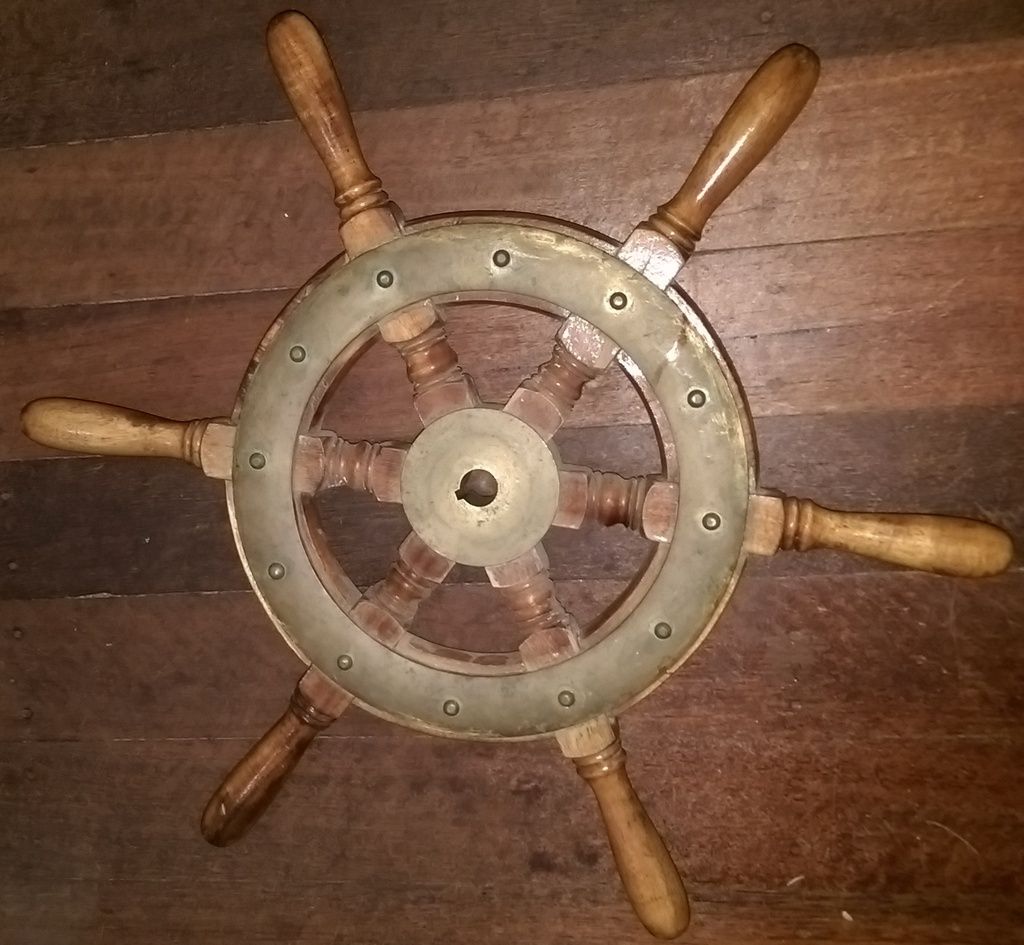 Needs Pictures: 0
Needs Pictures: 0
 Picture(s) thanks: 0
Picture(s) thanks: 0
Results 1 to 15 of 27
Thread: Caulking/Splining a carvel hull
-
9th March 2015, 06:08 PM #1
 Novice
Novice











- Join Date
- Feb 2015
- Location
- Perth
- Posts
- 21
 Caulking/Splining a carvel hull
Caulking/Splining a carvel hull
Hello all,
I have acquired this beauty.
carvel_hull_1.JPGcarvel_hull_2.JPGcarvel_hull_3.JPG
She is 22' long, and the framing appears to be nearly all in excellent condition. One plank needs replacing, and when we have stripped her perhaps there will be others, but this doesn't seem likely. She's a good hull. The deck needs replacing. The price was right.
I have her on a duel-axle trailer and would prefer to use her as a trailer boat. My main question at this point is, what are the options for sealing her up?
I think cotton and putty will be no good because the boat will be dry most of her life. I have considered splining, but it's a lot of work and the scare stories concern me. I don't know if a flexible product like a silicon or sikaflex would do the job, because it wouldn't stiffen up the hull, merely seal it.
Is there an answer?
-
9th March 2015 06:08 PM # ADSGoogle Adsense Advertisement
- Join Date
- Always
- Location
- Advertising world
- Posts
- Many
-
9th March 2015, 09:54 PM #2
 Senior Member
Senior Member











- Join Date
- Dec 2013
- Location
- Wollongong
- Posts
- 116

I'm sure some good advice will follow on this, but in the meantime try and cover her over to keep off the sun and more importantly keep out the fresh water from the bilges.
Sikaflex is not intended to be used in v-joints such as carvel and in any case, please do not apply silicone anywhere!
If and when you replace the deck, make sure some internal bracing is used to prevent the hull from spreading outwards or otherwise termed 'hogging'.
The old paint will contain lead and so make sure to look after your skin and 'gills' during the rebuild.
-
9th March 2015, 11:03 PM #3
 Novice
Novice











- Join Date
- Feb 2015
- Location
- Perth
- Posts
- 21

Thanks mate.
The hogging question concerns me. The plan is to turn her into an open boat with a small raised foredeck, under which will be a head compartment. She has a Sole diesel, so I think I'll put a centre console immediately behind the engine box. Then around the sides a slatted bench seat, immediately under the gunwales. For this arrangement the "deck" will be essentially non-existent, except for the foredeck. I'm thinking perhaps a four inch wide deck along the sides. If this "deck" is framed properly, do I need to add some (low) bulkheads at some points along her length in order to stop the hull from spreading?
IMAG0429.jpg
-
10th March 2015, 07:02 PM #4
 Senior Member
Senior Member











- Join Date
- Dec 2013
- Location
- Wollongong
- Posts
- 116

Looks a good project boat and judging by the rib spacing, also a solid boat.
I would think yes to some bulkheads for additional reinforcement of the hull.
If you consider the splining way, there are flexible guides(CMT) of which I've employed for this kind of work.
It makes the job of routing out the seams a good deal easier,after caulking removal of course.
If the engine is a goer then you have yourself a real cheap boat, even after the restoration work.
Is the Sole' a Mercedes based unit ?
Surprised no-one else has chimed in as yet on this topic?
CR
-
10th March 2015, 07:13 PM #5
 Novice
Novice











- Join Date
- Feb 2015
- Location
- Perth
- Posts
- 21

Please tell me about these flexible guides. I presume they are some kind of batton for guiding the router or saw?
I haven't looked closely at the motor yet. I can turn it over with a spanner on the nut on the front of the crank, so it isn't seized, which is good. Other than that, I know nothing. How would I ID a merc vs any other brand of block? I presume they don't leave OEM branding on them when they marinise them?
-
11th March 2015, 09:35 AM #6
 Senior Member
Senior Member











- Join Date
- Dec 2013
- Location
- Wollongong
- Posts
- 116

The guides are 1200 long and costs about $100.00 ea from Carbatech.You could use a flexible timber batten,but I found these quite good, especially tight radius or compound curves.
On the engine,you would have to get a model no from the plate and I could research it. Some marine engine manufacturers dabble between different makes usually tractor based motors.Sole' are generally pretty good from what I hear and I know the multiple cylinder types were Mercedes based donks.
Regards
-
12th March 2015, 12:08 AM #7
 Novice
Novice











- Join Date
- Feb 2015
- Location
- Perth
- Posts
- 21

Thanks CR, cant find any ID plate on the motor, but here are some pics of it (and the gearbox), along with some photos of the hull as she is tonight.


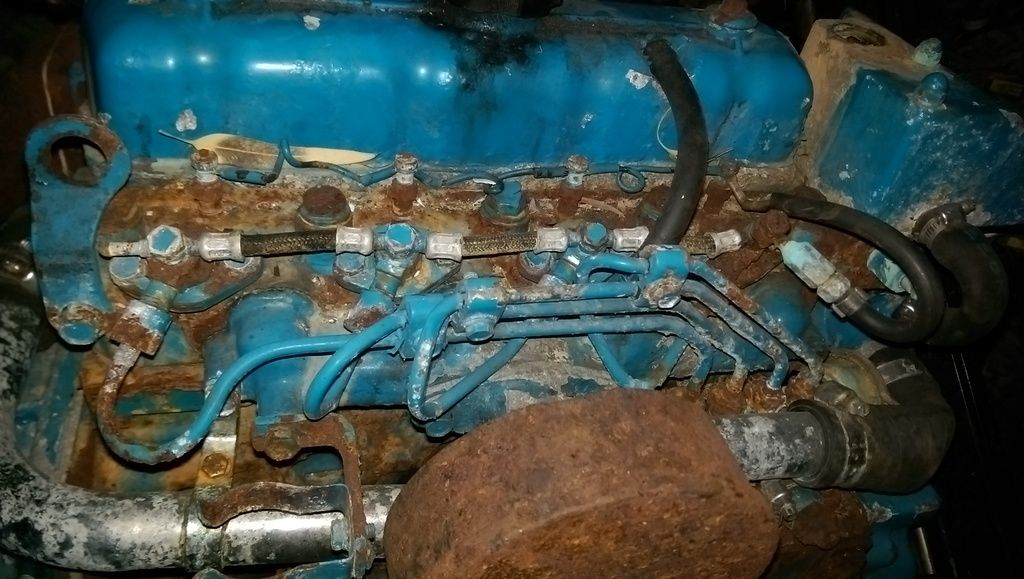
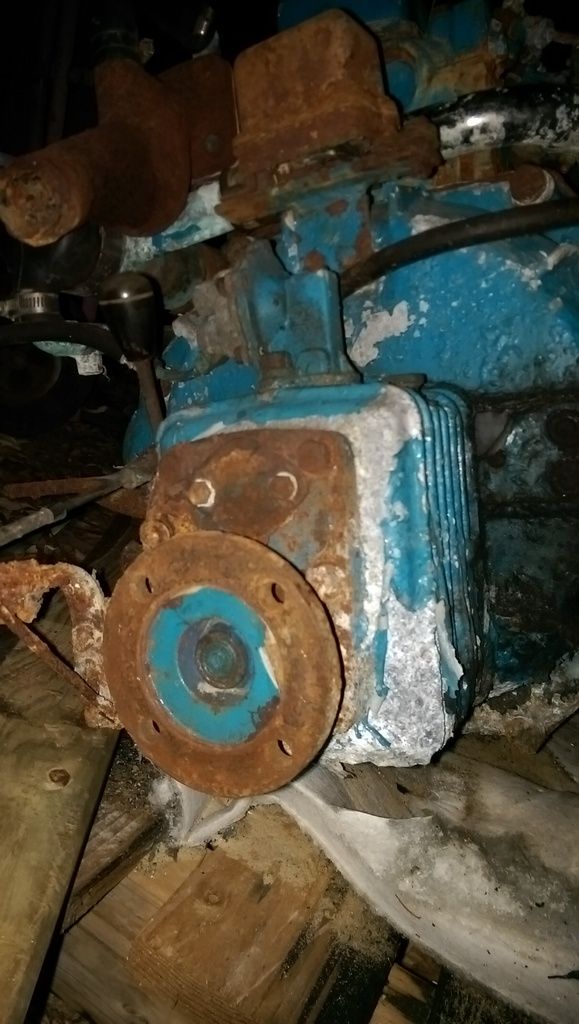
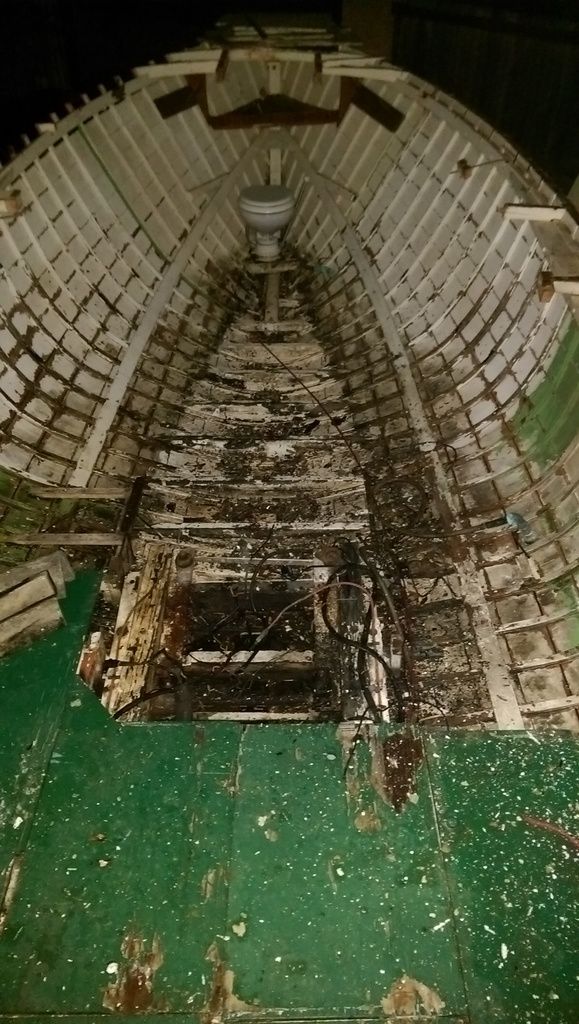
-
12th March 2015, 03:35 PM #8
 ~`
~`
Wedge seaming (spines) this hull will work, though there can be issues down the road. I'm more concerned about your proposed changes. This boat shows considerable distortion, some tension cracks in the frames and some other issues. With the removal of the deck, side decks and related structure, the hull has been dramatically weakened and this athwart and longitudinal stiffness needs to be restored or it'll leak like a sieve come launch day.
Generally, it's not wise to remove all this structure all at once, if you expect the boat to retain it's shape. This includes frame or planking repairs/replacements too. Typically, you pull every other frame or deck beam, unless the structure is weak, in which case you pull every third or forth frame or beam, make a replacement or repair then move onto the other, after returning the replaced/repaired element to the structure. Wholesale removal pretty much guarantees the hull will sag, settle, distort and other wise do weird things.
Generally there's a only a few ways to deal with these old carvels, the first and cheapest is to insure the structure can tolerate a new caulk job. This means the fasteners, their holes, the planking, frames, stringers, floors, carlins and cleats all need to be sound, other wise you're just wasting your time (and money). The second option is to skin the hull. There's only a few good ways to skin a carvel and cold molding a veneer is the usual course. If you only want a few more seasons from the old gal, then you can consider a 'glass sheathing, but this is typically a death nail, so only used on a tired, spent hull that needs to work a few more seasons, before it's dragged to the land fill
-
12th March 2015, 04:14 PM #9
 Novice
Novice











- Join Date
- Feb 2015
- Location
- Perth
- Posts
- 21

Sorry, PAR, can you tell me more specifically where you see these things?
Understood. This is what I had in mind:

I was thinking that the solid timber gunwale, the foredeck, the aft deck, and the floor supports/frames, would give her the stiffness required. I imagine that the splining will also essentially turn her into a monocoque shell, so there will be a lot of structural strength and rigidity added in that way. Am I mistaken?
-
12th March 2015, 04:49 PM #10
 Senior Member
Senior Member











- Join Date
- Sep 2008
- Location
- Wongawallan, SE Qld
- Posts
- 161

For what its worth, if you are wanting to keep her out of the water and trailer her I'd be going for splining and fibreglassing the hull.
Best way to do it will be to flip her over, get the shape right again in whichever way suits you best. I've seen this done when a hull is right way up by blocking in the right places and with weights in the hull, or flipped and with weights at the ends or with ratchet straps pulling the ends down bit by bit over time until it's where she should be and then braced inside with temporary bracing/bulkheads/longitudinals to hold her in place while structural repairs or additional frames are fitted. But it depends on the type of hull and where the shaping is needed as to what will work best for you.
Either way I'd definitely go to the trouble of flipping her to work on her as you'll find it much easier to reshapem spline, glass and paint.
Glassing will provide additional strength to retain the shape once you've recovered it and will allow you to keep her out of the water, but two things if you go this path are important:
* there must be absolutely no rot under the glass/epoxy as this will just spread and make a real mess of the hull in short time
* the timber must be properly dry and prepared prior to glassing - again any trapped moisture will promote rot under the glass.
As for splining, I've done it very successfully with a steady hand and a circular saw to spline failed glue lines on a glued strip planked hull. It's easy enough to follow the seams by eye if you take it easy and the blade will naturally want to follow the seam anyway as long as you don't try to rush it.
Your hull would be even easier than the strip planked one as the seams are more defined and open and if you can flip the hull it will be so much easier on your back and neck. I didn't want to remove my lead keel and the hull is 28' so it wasn't as easy to flip as yours will be...otherwise I would have:
A saw-cut seam and another open one next to it awaiting the same treatment

saw set to depth of planks only:

some splines:

glued in before sanding back:

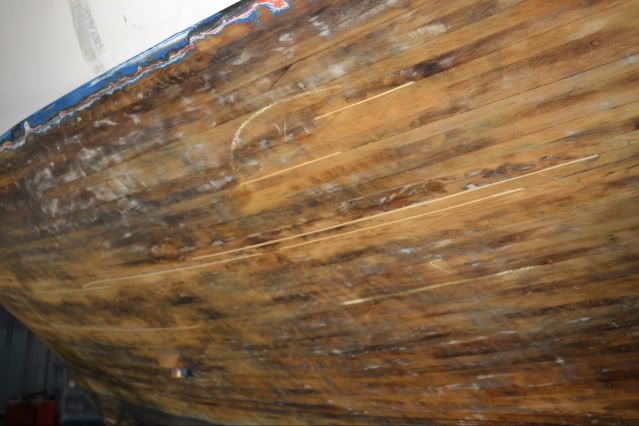

-
13th March 2015, 11:53 AM #11
 Novice
Novice











- Join Date
- Feb 2015
- Location
- Perth
- Posts
- 21

Fantastic, thanks Larks. I will take your advice and flip her over. The motor is out, and the lead ballast was loose, so that's out too. Shouldn't be pretty easy to get her over.
CR, the motor is a Sole Mini 32, 28 hp – 3000rpm. The block is a Mitsubishi K4C.
-
13th March 2015, 11:57 AM #12
 Senior Member
Senior Member











- Join Date
- Sep 2008
- Location
- Wongawallan, SE Qld
- Posts
- 161
-
13th March 2015, 10:32 PM #13
 Senior Member
Senior Member











- Join Date
- Dec 2013
- Location
- Wollongong
- Posts
- 116

I thought it a rather large motor with 4 injectors showing in the previous pictures.You could easily push along a 6 tonne yacht with that thing!
A 10-12 Hp unit would suffice for your boat.
Possibly the older Sole' versions were Merc based and yours might not be that ancient afterall.
With some cosmetic clean up,could be very good indeed.
Do you think the planking is Jarrah?.It does look quite rich in colour with superb grain.Might be the reason as to why it has survived so well.
Also, some good information on offer from the 'gurus' as well to help you along.
Have a good look and probe around with a screwdriver to determine how sound the timber is overall.At the endgrain or joints is usually a telling area.
Cheers.
-
14th March 2015, 08:39 PM #14
 carmen
carmen











- Join Date
- Jul 2006
- Location
- brisbane
- Posts
- 65

you've had plenty of good advice as to splining, so here is my two cents worth.
I have splined a 30' deep keeler, removed ballast and turned her over, so much easier to work downhill, after a suitable time drying her out and complete paint removal the fun began. I used battens tacked to the hull to keep the 6" circular saw in place and made a series of light runs, too deep and the caulking cotton just jammed up the saw, any area that the saw could not reach I used a file bent over at the end and sharpened to rake out whatever caulking was left. Next step was to run a router down the seam to remove putty/paint crud and to give a fresh face to the timber, wet out the seams and used a syringe to fill the seam with glue and a shaped paddle pop stick to press the glue down and have glue up the sides, the new splines were pressed in and packing tape covered ply strips tacked over the seam to hold the new spline in, otherwise the glue will act as a lubricant causing the spline to move around. The lenght of the spline depended on the curvature of the hull, I also made sure that any excess glue squeezed through on the inside was removed before it went off. It would be a good idea to pull the hull into shape before turning her over, with whatever means you have at your disposal, bulkhead, ring frame whatever, once splined it will be really difficult to pull her back into shape. Lastly I assume it is all under cover.
By the inch it's a cinch, by the yard it's too hard.
-
15th March 2015, 10:30 AM #15
 Novice
Novice











- Join Date
- Feb 2015
- Location
- Perth
- Posts
- 21
Similar Threads
-
Help with replacing a carvel hull that has seen better days
By Hawko in forum BOAT BUILDING / REPAIRINGReplies: 10Last Post: 16th May 2016, 10:51 PM -
21ft Restricted Class yacht - Huon Pine carvel planked, hull only $500
By SimonP in forum CLASSIC BOAT RESCUE & ADOPTIONReplies: 1Last Post: 20th July 2010, 10:29 PM -
hey every body i need help building a carvel hull
By hemayann in forum BOAT DESIGNS / PLANSReplies: 10Last Post: 17th February 2009, 03:45 PM -
32' foot spotted gum carvel timber hull
By Halvorsen style in forum BOAT BUILDING / REPAIRINGReplies: 2Last Post: 31st January 2009, 07:27 PM -
wood splining
By smithbri1 in forum WOODWORK - GENERALReplies: 0Last Post: 15th July 2005, 11:35 AM



 Thanks:
Thanks:  Likes:
Likes: 
 Reply With Quote
Reply With Quote
 .
.
